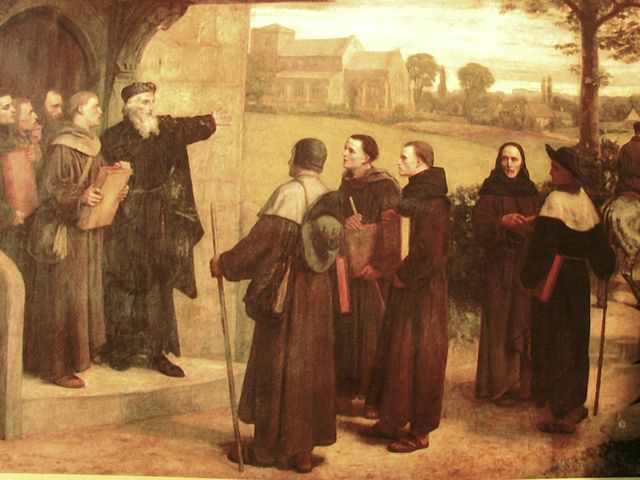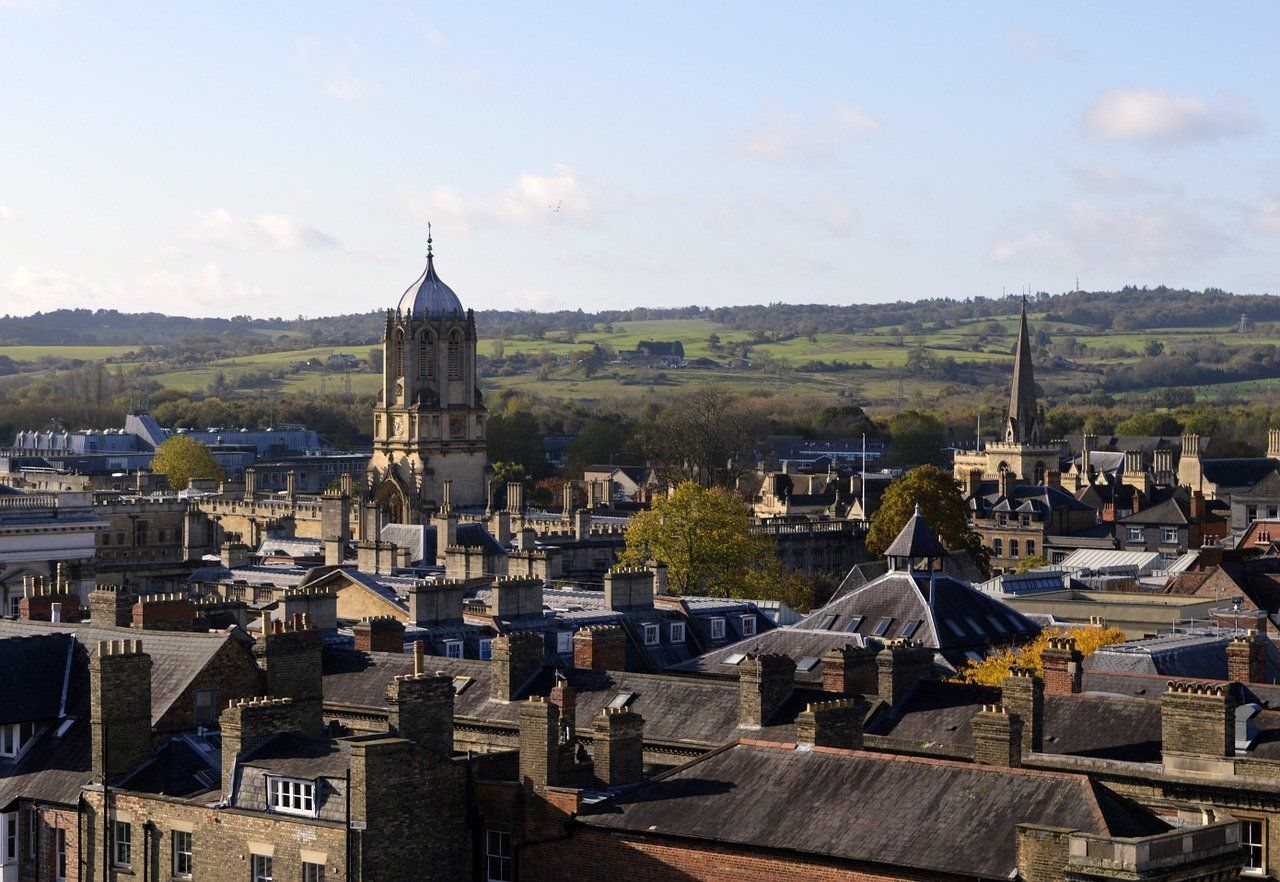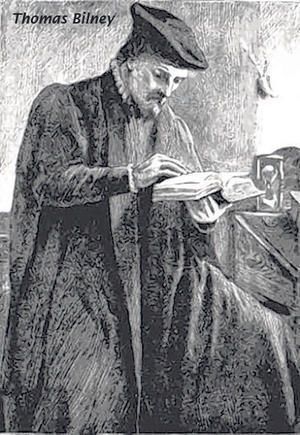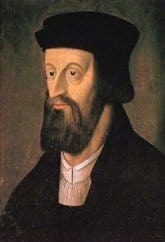
Last month we drove in imagination down the M1 passing junction 21. Noting the sign ‘River Swift’ on the motorway embankment, we reminisced as we looked back to the fourteenth century, to see a great man of God whose pioneering work was so influential that he was called the ‘Morning Star of the Reformation’.
This month we face the question, ‘What happened next?’ History is not only the chronicle of past events. It forces us to ask questions. What were the strengths and weaknesses of the movement begun by Wycliffe? What happened after his death? How did things develop over the years till the clarion call of Luther was heard? The answers are to be found in the history of the Lollard movement in England and the story of John Huss of Bohemia.
Wycliffe had ended his life peacefully in Lutterworth. The popes were frustrated that they were too late to torture and kill him. They decided, however, to step up the persecution of his followers. The first stage was the passing in 1401 of the statute on the burning of heretics. The full fury of the papal torture machine was already in action in Europe. Now Britain would taste it. Some would falter, but others stood firm, and great numbers perished. We need to recall these forgotten ones from sad obscurity, and see how vital a part they played in the movement which would eventually erupt as the Protestant Reformation.

Oxford
The nickname ‘Lollard’ was doubtless coined by critics as a contemptuous dismissal. At a time when English was particularly open to words from other languages, this word had its roots in Dutch. It could mean ‘mumbler’ or ‘mutterer’. Clearly, it reflected the reaction of those who loved the ornate rituals of the mass, and echoed their contempt for the simplicity of the Lollards’ ‘mumbling’ prayer meetings!
The Lollards insisted that the current notion of a sacrificing priest should give way to the real calling of the ministry, which was to preach the Word. This led to their emphasis on the centrality of the Scriptures and, as a result, they aimed to translate the Bible into the language of the people. They also rejected such Roman errors as transubstantiation, prayers for the dead, images in the churches, and pilgrimages to acquire merit.
At first they were largely a group of Oxford men whom Wycliffe trained and sent out to preach. After Wycliffe’s death they moved their headquarters to Leicester, only a few miles from Lutterworth where Wycliffe died in 1348. Their leader was William Swinderby. I noted earlier that this was a period when surnames became standardized. It was therefore a pleasant but understandable surprise when, driving along the A46, I saw a prominent village sign — ‘Swinderby’. So this was where his roots were!
The Lollards reached out from Leicester across the Midlands and up to Scotland. The first Scottish Lollard martyr was Patrick Resby, to be joined by Paul Crawar, burned at the stake in St Andrews in 1433. It is a mark of the inroads they made that in 1426 the Scottish parliament called on the bishops to ‘uproot lollardy’.

The persecution raged on in England. In 1511 Ammonious Sacchus, Latin secretary to Henry VIII, wrote to the Dutch humanist Erasmus: ‘Wood has become scarce in London; so much is being used for burning Lollards.’ It is not surprising, therefore, that when the first of the Cambridge martyrs, Thomas Bilney, was burned outside Norwich, he met his death in ‘the Lollards Pit’. The title was a grim reminder of its earlier use.
Prague
The Lollard movement later merged into the Protestant Reformation and the Anabaptist movement. From its earliest days it had a European dimension. In the fulness of time, this would lead to the celebrated Moravian missionary movement. Much of that lay in the future, but in the meantime God’s providence was displayed in the spread of the gospel from Oxford and Lutterworth to Prague.
The Czech link began with the marriage of Princess Anne of Bohemia to Richard II of England. This was doubtless, in the minds of most, just another arranged royal marriage alliance. However, in God’s purposes, diplomacy is subject to his sovereign direction. Through that providence, Czech students came to Oxford, and there they discovered Wycliffe’s works. They also met what were termed ‘hedge priests’, carrying the gospel to the villages of England. They returned to Prague, and the message they carried back brought liberation to the celebrated priest of the Bethlehem chapel in Prague. University academic and popular preacher John Huss welcomed the new teaching, which was really the old teaching of the Bible now reaching the people.

Moravia
This ministry was too much for Rome! The Council of Constance had to be summoned to decide the validity of the different claimants to the papacy. Two popes competed vigorously until John XXIII was ejected. So John Huss was, in a sense, just an extra item on the agenda. Here was Rome at her worst. Huss had been given a guaranteed safe conduct by the emperor. When he arrived in Constance, however, the safe conduct was cynically torn up — there was no need to keep faith with a heretic! Huss was imprisoned, given a travesty of a trial, and finally burned to death. Another martyr was one of the former Oxford men, Jerome from Prague, who courageously faced the same brutal execution. For generations ahead, the Bohemians would face unremitting persecution. However they survived as the Moravians, who were in the future to become one of the most dynamic missionary movements ever, reaching out across the world.
Full circle
In a remarkable future meeting in mid-Atlantic between a leading Moravian and a failed English missionary called John Wesley, Spangenberg’s probing question, ‘Do you know Jesus Christ?’ led to Wesley’s self-examination and later assurance. The wheel had turned full circle. The recovery of the gospel by the Master of Balliol was to revive a former fellow of Lincoln College and drive the famous ‘Holy Club’ in Oxford to reach England and the world with the gospel. Our God, wrote Paul, is the one who ‘works out everything in conformity with the purpose of his will’ (Ephesians 1:11).






